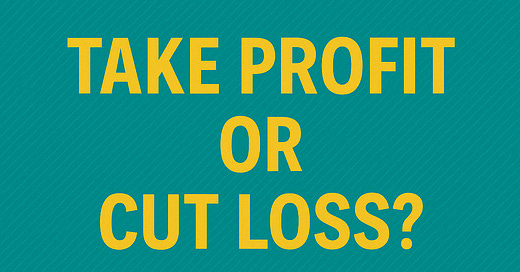Take Profit or Cut Loss? A Simple Guide for Beginner Traders
Struggling with when to exit a trade? Here's how to handle profits and losses with less stress and more confidence.
One of the hardest things in trading isn’t entering a trade, it’s deciding when to exit. Should you close your trade and take the small profit now, or wait for more? Should you cut your loss, or give it more time?
These are decisions every trader faces. And if you're new to trading, it’s completely normal to feel unsure. But there’s a way to make it easier: follow a clear plan instead of relying on emotions.
Here are five simple rules that can guide your exit decisions:
1. Cut Losses Early
Many beginners hold on to losing trades, hoping the price will bounce back. But often, the loss just gets worse.
To avoid this, always set a stop loss before entering a trade. This is the price where you’ll accept that the trade didn’t work out and exit with a small, controlled loss.
Think of a stop loss as your seatbelt. You hope you don’t need it, but it’s there to protect you.
Letting losses run too far can damage your account and your confidence. Small losses are part of the game, big losses can take you out of the game.
2. Let Winners Ride (But With a Plan)
It’s tempting to take profits quickly, especially if you’ve had a few losing trades. But closing too early can limit your growth.
Instead, plan your take profit level before you enter. This helps you stay focused on your original goal.
You can also use a trailing stop, which moves your stop loss as the price moves in your favor. That way, if the market turns around, you lock in some profit without exiting too soon.
Example: If your trade goes up by 50 pips, you can adjust your stop loss to secure 30 pips. If the price drops after that, you still keep the 30-pip profit.
3. Use a Risk-to-Reward Ratio
Don’t risk $50 to make $20. That’s a losing formula in the long run.
A simple rule is to aim for at least a 2:1 reward-to-risk ratio. That means for every $1 you risk, you aim to make $2 or more.
Even if you’re only right 50% of the time, this helps you grow your account slowly and steadily.
4. Trade With a Plan — Not Emotions
When you're in a trade, it’s easy to second-guess yourself. You may want to move your stop loss or take profit level out of fear or excitement.
But changing your plan on the fly usually leads to poor results.
The best traders make decisions before they enter a trade — not while their emotions are running high.
Write down your plan:
Entry price
Stop loss
Take profit
Then follow it. Simple, but powerful.
5. Review Your Trades
After each trade, take a few minutes to reflect. Ask yourself:
Did I follow my plan?
Was my exit decision based on logic or emotion?
What can I do better next time?
This habit helps you learn faster and builds confidence in your strategy. You’ll start to see patterns — what works and what doesn’t.
Final Thoughts
You won’t get every trade right. That’s okay.
The key is to protect your capital when you’re wrong and maximize gains when you’re right. With practice, you’ll get better at exiting trades calmly and confidently.
Trading is a skill. Like all skills, it improves over time — especially when you trade with a plan.
For support, contact us at support@easyindicators.com.




